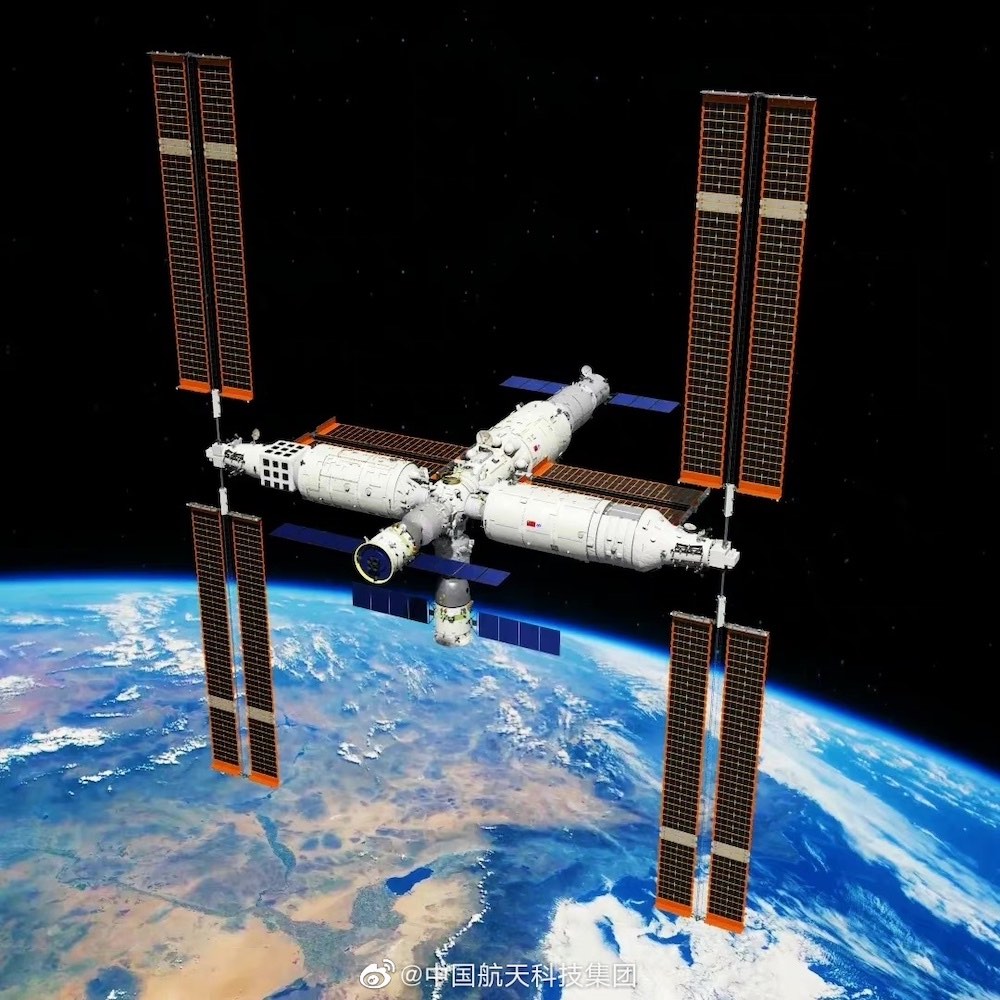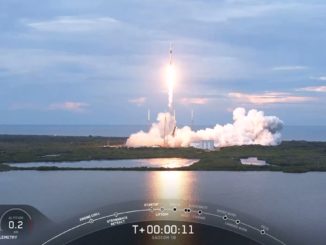
The next three-man crew to live on China’s Tiangong space station will launch Monday night on a Long March rocket, heading for a half-year expedition on the orbiting outpost to replace an outgoing team of astronauts set to return to Earth this weekend.
Led by veteran commander Jing Haipeng, the crew for China’s Shenzhou 16 mission will strap into their seats for a 10-minute ride into orbit following liftoff on a Long March 2F rocket from the Jiuquan launch base in northwestern China at 9:31 p.m. EDT Monday (0131 UTC Tuesday). The launch time is set for the instant that the mission needs to take off to rendezvous with the Tiangong space station, when Earth’s rotation brings the launch pad under the path of the orbiting lab soaring about 240 miles (390 kilometers) above Earth.
The launch of the three-man Shenzhou 16 crew will, for a day, bring the total population of humans in low Earth orbit to 17, breaking the previous record of 14 people in orbit at one time. There are three Chinese astronauts already aboard the Tiangong space station, ready to be replaced by the Shenzhou 16 crew, and 11 people on the International Space Station — five Americans, three Russians, two Saudis, and one Emirati astronaut.
That will change Tuesday with the scheduled undocking and return to Earth of a SpaceX Crew Dragon spacecraft to complete a nine-day private astronaut mission managed by Axiom Space, returning the International Space Station to its regular crew complement of seven astronauts and cosmonauts.
Shenzhou 16 will dock with the Tiangong space station Tuesday, temporarily bringing the crew of the Chinese station to six. The three Chinese astronauts who have lived and worked on the Tiangong space station since November are slated to depart in their Shenzhou 15 crew capsule Saturday to head for re-entry and landing in China.
Chinese ground teams rolled the 191-foot-tall (58-meter) Long March 2F rocket to the launch pad May 22 in preparation for the Shenzhou 16 mission. Gantry arms enclosed the launcher as technicians completed final processing and inspections on the rocket. Loading of several hundred tons of toxic hydrazine and nitrogen tetroxide propellants into the rocket began Monday.
The three astronauts will climb into the Shenzhou 16 crew module about two to three hours before liftoff.
A core stage engine and four strap-on boosters will ignite to generate 1.4 million pounds of thrust, driving the rocket and crew eastward from Jiuquan in pursuit of the Chinese space station. The Long March 2F will consume thousands of gallons of toxic, corrosive propellants to accelerate the 8.5-ton Shenzhou 15 spaceship into orbit.
The second stage of the rocket will deploy the crew craft about 10 minutes into the mission. Moments later, Shenzhou 16 is programmed to unfurl its solar panels to begin producing its own electricity.
The spacecraft will fire thrusters to fine-tune its approach to the Chinese space station, culminating in an automated docking at the Tianhe core module later Tuesday. The astronauts will open hatches and float into the Tianhe core module to begin their work.

Chinese officials revealed the identities of the astronauts on the Shenzhou 16 mission Monday, about 24 hours prior to the scheduled launch time. In contrast to the U.S. and Russian space programs, China typically keeps its crew assignments secret until the day before launch.
The crew is commanded by Jing Haipeng, 56, a major general in China’s military and a former fighter pilot in the Chinese Air Force. Jing, who joined China’s astronaut corps in the first group selected in 1998, will become the first Chinese astronaut to launch on four space missions, following previous flights in 2008, 2012, and 2016.
In a press conference Monday, Jing said he has studied and memorized more than 70 flight manuals and thousands of operating instructions. He has logged 47 days in orbit on his three previous missions.
“At this moment, to be honest, I feel very peaceful because, as an astronaut, going to space is our main responsibility and main business, and winning glory for the country is our … mission,” Jing said in translated remarks.
The three-man Shenzhou 16 crew will replace the Shenzhou 15 astronauts, who launched Nov. 29 and are now wrapping up a half-year in orbit. Shenzhou 15 commander Fei Junlong and astronauts Deng Qingming and Zhang Lu took the place of the Shenzhou 13 crew.
Two spaceflight rookies will join Jing on the six-month expedition on China’s Tiangong space station.
Zhu Yangzhu, another Chinese pilot and military officer, will serve as spaceflight engineer. Gui Haichao is a payload specialist on the Shenzhou 16 mission, and will become the first civilian astronaut to fly in China’s human spaceflight program.
“As an aerospace flight engineer, under the leadership of the commander, I will complete the daily maintenance, maintenance and repair tasks of the space station assembly, carry out load care and actual tests, and ensure that the space station can be safe, stable, efficient and long-lasting,” Zhu said Monday.

Gui will be responsible for overseeing the scientific experiments on the Tiangong space station, which consists of the Tianhe core module and two attached pressurized lab modules. China completed the initial assembly of the Tiangong space station last year, and the complex is transitioning from construction to a new phase of scientific utilization.
China launched an piloted cargo ship to the Tiangong space station earlier this month to deliver food, supplies, experiments, and other hardware for use by the Shenzhou 16 crew.
“This mission is the first manned flight to the Chinese space station after it entered a new stage of application and development,” Jing said. “As you can see today, a brand new (crew) combination also made its debut. Our crew is composed of the pilot, the first aerospace engineer and the first payload expert, which also means that we will undertake more complex, arduous and arduous tasks.”
Email the author.
Follow Stephen Clark on Twitter: @StephenClark1.



